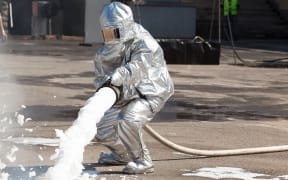A major firefighter training site in Taranaki has been stopped from discharging wastewater while investigations carry on into foam contamination.

Photo: 123RF
An abatement notice on the fire training centre at the Maui Production Station, near Opunake, is still in force.
The regional council issued the notice in November 2016 "following observation of some foaming" in the Oaonui Stream during an inspection.
The discharge permit expired three weeks ago and the council is refusing to issue a new one to the training company Wood Group M & O.
Read the discharge permit in full (PDF, 2.1MB)
"The assessment of the application is on hold, pending the outcome of the current regulatory investigation ... into the use and effects of PFAS-based firefighting foams."
Under the nationwide investigation, the government has ordered regional councils to track down possible sources of foam pollution as concern about its health impacts grows.
Petrochemical industries typically store lots of foam, needed to completely cover potentially widespread fires across tank farms. But the New Zealand investigation has so far barely mentioned these industries.
The Taranaki training site has been allowed to discharge wastewater into the Oaonui Stream since 1975, but the permit isn't explicit about foam.
"Fire-fighting foams were not explicitly addressed within the consent to either allow or prohibit," the council told RNZ in an Official Information Act response.
The foam chemicals, called PFASs, are extremely long-lasting and build up in the body with repeated exposure, most commonly by drinking contaminated water.
The Defence Force has also been using the Taranaki site after it discovered in late 2014 it had contaminated the groundwater around its airbase at Ōhakea in Manawatū, and subsequently found other contamination sites in Marlborough and Auckland.
Defence said the Ōhakea crews at Taranaki had stopped training with the fluorine foams that contain PFASs.
The regional council permit said fire training exercises at the Māui site are run about once a fortnight.
The runoff went into two holding ponds and then into the Oaonui Stream a few times a year, the permit said.
Read the Official Information Act response relating to the water discharge consent (PDF, 323.7KB)
But in the OIA response, the council said the discharges into the stream "were very rare, of the order of a couple of events per year".
The long-lasting foam chemicals are highly soluble and extremely hard to get out of water.
They do not show up in tests unless they are specifically targeted.
The Defence Force has been doing targeted tests for three-and-a-half years, but it has not used an additional newer test that measures total quantities of PFASs.
Defence has failed since April to release internal reports on this new way of testing to RNZ, even though the government has said it was "essential" to use this testing in order to gauge long-term health impacts.
Two of the foam chemicals, PFOS and PFOA, are banned in New Zealand, but fluorine foams contain hundreds of other related PFAS compounds that research indicates behave in similar ways.
RNZ has asked the regional council if it has tested the stream water or groundwater for foam contamination, or if it planned to.



